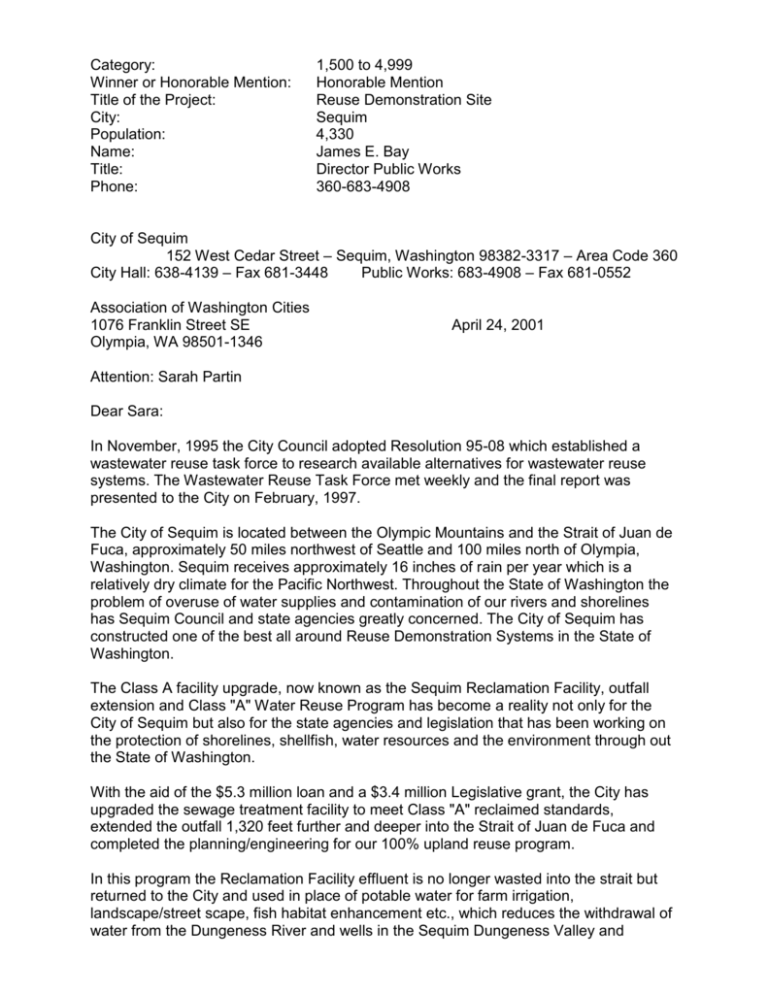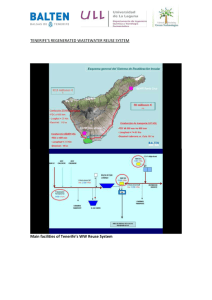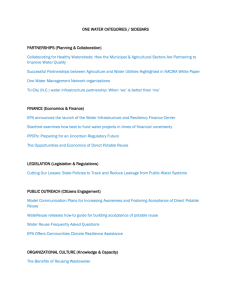Reuse Demonstration Site - Association of Washington Cities
advertisement

Category: Winner or Honorable Mention: Title of the Project: City: Population: Name: Title: Phone: 1,500 to 4,999 Honorable Mention Reuse Demonstration Site Sequim 4,330 James E. Bay Director Public Works 360-683-4908 City of Sequim 152 West Cedar Street – Sequim, Washington 98382-3317 – Area Code 360 City Hall: 638-4139 – Fax 681-3448 Public Works: 683-4908 – Fax 681-0552 Association of Washington Cities 1076 Franklin Street SE Olympia, WA 98501-1346 April 24, 2001 Attention: Sarah Partin Dear Sara: In November, 1995 the City Council adopted Resolution 95-08 which established a wastewater reuse task force to research available alternatives for wastewater reuse systems. The Wastewater Reuse Task Force met weekly and the final report was presented to the City on February, 1997. The City of Sequim is located between the Olympic Mountains and the Strait of Juan de Fuca, approximately 50 miles northwest of Seattle and 100 miles north of Olympia, Washington. Sequim receives approximately 16 inches of rain per year which is a relatively dry climate for the Pacific Northwest. Throughout the State of Washington the problem of overuse of water supplies and contamination of our rivers and shorelines has Sequim Council and state agencies greatly concerned. The City of Sequim has constructed one of the best all around Reuse Demonstration Systems in the State of Washington. The Class A facility upgrade, now known as the Sequim Reclamation Facility, outfall extension and Class "A" Water Reuse Program has become a reality not only for the City of Sequim but also for the state agencies and legislation that has been working on the protection of shorelines, shellfish, water resources and the environment through out the State of Washington. With the aid of the $5.3 million loan and a $3.4 million Legislative grant, the City has upgraded the sewage treatment facility to meet Class "A" reclaimed standards, extended the outfall 1,320 feet further and deeper into the Strait of Juan de Fuca and completed the planning/engineering for our 100% upland reuse program. In this program the Reclamation Facility effluent is no longer wasted into the strait but returned to the City and used in place of potable water for farm irrigation, landscape/street scape, fish habitat enhancement etc., which reduces the withdrawal of water from the Dungeness River and wells in the Sequim Dungeness Valley and sustains a steady flow of water in Bell Creek, protecting Salmonid and providing conservation. The Council's program is to beneficially reuse one hundred percent of its treated municipal wastewater. The impetus for this program is an agreement signed by the City in 1994 with the Washington State Departments of Ecology and Fish and Wildlife. This agreement ended years of contention over closure of shellfish beds in Sequim Bay due to the location of the City's wastewater outfall. With this agreement, the City Council has upgraded its wastewater treatment plant to a Class "A" reclaimed water facility and investigating future alternatives for reuse of the reclaimed water to achieve the goal of one hundred percent reuse. The treatment plant upgrade and outfall extension was completed in February 1999 and the City began producing Class "A" reclaimed water at that time. The City Council formed a Water Reuse Task Force to create a foundation for a technical evaluation of reuse alternatives. The task force consisted of a diverse group of local community members as well as ad hoc members from agencies that included the Washington State Departments of Ecology, Department of Health, Department of Fish and Wildlife, Puget Sound Water Quality Action Team, Jamestown S'Klallam Tribe and many others. The March 1997 Water Reuse Task Force Report identified and prioritized a number of reuse alternatives. The number one alternative identified in the task force report was enhancement of Bell Creek. Other high priority alternatives included irrigation of parks, schools and golf courses. Funding for the construction of a water reuse system was provided by a special legislative action that established reclaimed water demonstration projects for the five Washington communities. The City received a grant in the amount of $3,398,500 under this legislation which specifically called for developing a water reuse system that would "reopen an existing shellfish closure area to benefit state and tribal resources, improve stream flows in the Dungeness River and provide a sustainable water supply for irrigation purposes." To meet the objectives of the citizen's Reuse Task Force Report and RCW's relating to the legislative funding requirements, an amendment to the City's Wastewater Facilities Plan was completed and approved by DOE & DOH providing a designed report for the Class "A” water reuse system that includes the elements described below. 1. Construction of an 18-inch trunk pipeline to convey Class "A” reclaimed water to the City Shop, DOT/City of Sequim Rest Stop and Restroom Facilities. In the first phase of the project lateral pipelines have been installed to deliver water to a city park (Carrie Blake park), the new DOT and City of Sequim joint Highway 101 bypass rest area, City street scape and Reuse Demonstration Site Education and Interpretive Center. The City Shop will serve as a hub for future distribution line extensions as well as a reclaimed water dispensing station to serve a variety of uses including fire fighting, City vehicle washing, street cleaning and construction water needs (dust control, compaction). 2. Creation of a Reuse Demonstration Land Application Site immediately north of Carrie Blake Park. This site includes constructed wetlands that are used to cool and re- aerate the reclaimed water prior to its introduction into Bell Creek at the City park. The site will be heavily landscaped and irrigated showing a large variety of plant life and different types of irrigation systems all using reclaimed water. An Interpretive Center will be constructed at the demonstration site to serve as a focal point for community education on the overall benefits of reuse. 3. Stream flow Augmentation of Bell Creek. Bell Creek has been identified as seriously deficient in flows to support native salmon spawning and rearing. The City is committing 0.1 cubic feet per second (cfs) of its reclaimed water to augment flows in Bell Creek to help improve salmon habitat on a year round basis. Initial estimates of Dungeness River stream flow improvements are identified in this report as follows: 2.6 million gallons per year based on replacement of existing potable water usage at Carrie Blake Park with reclaimed water. 48 million gallons per year based on augmenting stream flows in Bell Creek with a minimum of 0.1 cfs year round. (This is in cooperation with Highland Irrigation District and their reduced withdrawals from the Dungeness River by 0.2 cfs) 14.4 million gallons per year by substituting reclaimed water for potable water for City uses. The City Council and Community is very proud to have built a Reclamation Facility that produces 100% of all the sewer inflow into a very usable and environmentally safe water resource. This resource is brought back to the community and reclaimed, saving withdrawals from the Dungeness River and the City's well fields and providing a very effective water conservation program. We are very honored to be able to send you this summary letter and the entry form for the 2001 AWC Municipal Achievement Awards. If you have any questions, please contact the City Manager, or Project Manager, James E. Bay at (360) 683-4908. Sincerely, Bill Thomas Mayor City of Sequim







